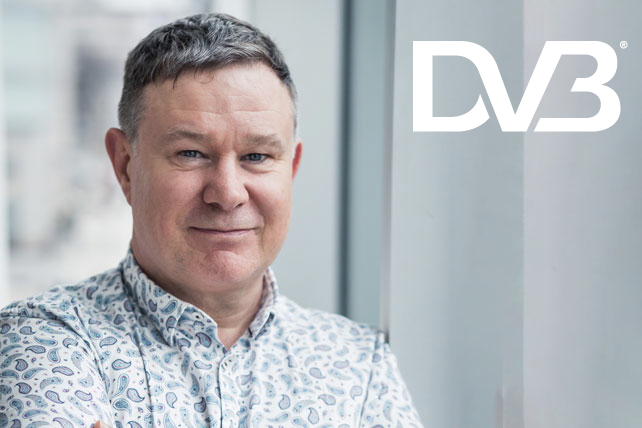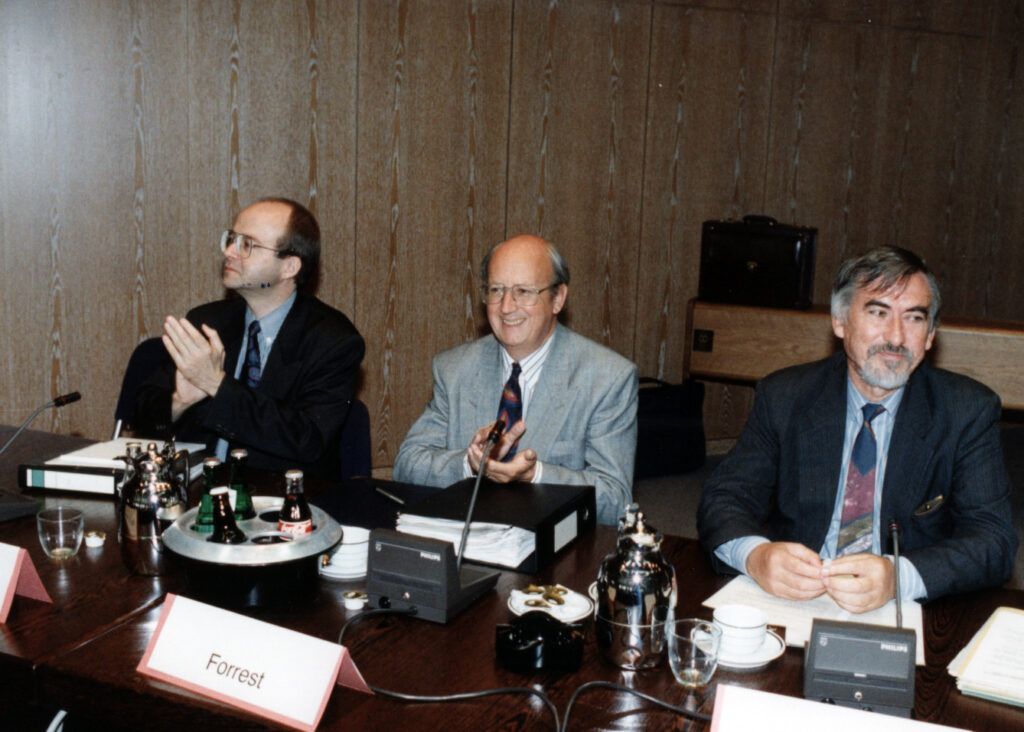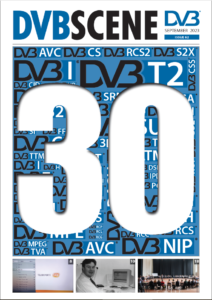
Hindsight, foresight and insights – interview with Peter MacAvock on DVB’s 30 years
Peter MacAvock has been at the heart of the DVB Project since just after its creation, having been hired to run the DVB Project Office in January 1994. He left in 2008 to take up a fulltime position at the European Broadcasting Union but was elected chair of DVB in 2016. The September 2023 issue of DVB Scene magazine featured this interview with him on the state of DVB on its 30th anniversary.
DVB Scene: You’ve said this will be your final mandate as DVB’s chair. What’s the ideal profile for your successor?
Peter MacAvock: Ideally the next chair of the DVB Project will be drawn from a generation of people who didn’t know DVB’s foundation, who have scant regard for its reputation but recognize its unique selling points. It should be someone who will seek to wipe away the cobwebs and build an organization that’s dynamic and diverse. DVB still counts for something but arguably the reason it still counts is its legacy, which is also what weighs it down.
DVB Scene: There are many more standards developing organizations, SDOs, in the media space today than there were 30 years ago. Discuss.
PMA: There are many, many more. But while DVB looks like a standardization body, it’s actually not one. If I look at the way in which similar problems were addressed in other territories, like in the US and Japan, the bodies that produced the technical specifications in those territories were standardization bodies with related mandates, whereas the DVB Project was industry-led and made sure it was, in an effort to dissociate itself from the regulation that might be associated with a standardization mandate. We’ve been careful to make sure that DVB remains an industry-led specification-producing body that then subsequently standardizes its work outside, in ETSI.
DVB Scene: When you came on board a few months after DVB was created, were you aware of these differences?
PMA: The process by which the DVB Project came together saw the emergence of the primary difference between DVB and other such groups, namely the Commercial Module (CM). DVB originally proposed to look at delivering HD over terrestrial: the European Launching Group (ELG), chaired by Ulrich Reimers, had produced a report setting out what needed to happen in order to make HD digital terrestrial television (DTT) a reality. The public broadcasters and the ELG made an approach to the pay-TV operators
who stipulated that, if they were to support a standardized approach to digital television, it needed to focus on multichannel SD satellite delivery before it focused on HDTV. Ultimately that proved to be the correct approach – there was an economic driver for multichannel satellite SDTV that simply didn’t exist for HDTV services.
Right from the outset DVB has asked whether it is commercially sensible to do a particular technology solution. Commercial requirements that were produced at that time looked very much like commercial requirements. If you look at the satellite CRs, they focused on dish size, on a typical house installation. They didn’t focus on a performance criteria – they focused on cost and convenience.

DVB Scene: Are the reasons for DVB’s existence different today?
PMA: The singular focus the DVB Project had at launch was to allow the industry to shape its own future and its own future was relatively clear at the time. The situation is far more complex now and arguably the industry is undergoing a change that’s even more fundamental than those that took place back then, from analogue to digital and from SD to HD.
What we’re now seeing is a convergence between two big data delivery systems, telecoms and television. We see the rise of the big tech SVOD streamers operating in an environment that’s less regulated than the one in which DVB Members traditionally operate and therefore allows greater flexibility. In terms of their technology choices, they don’t look much to the world of standardization; they’re looking towards the more vertically integrated app-based approach where user data is very carefully guarded and protected. It’s a space where the opportunities for standardization are different and are being met by organizations that are typically outside the media space, like W3C and the IETF.
DVB Scene: With this increasingly dominant ecosystem that grew up outside DVB, the broadcast world is having to run to catch up. Is DVB still relevant?
PMA: That’s a big question. The reason we work so hard for interoperability between services and devices, and the reason a free-to-air market has flourished for decades, is that the economics are based on interoperable technical solutions – I’m not going to call them standards here – and it works. We’re seeing a trend where the subscription video-on-demand companies are more and more seeking to develop interoperable, common solutions. They’re relearning the value of standardization, not in the formal sense but agreeing on technology choices, which allows a multivendor interoperable ecosystem to build up, and then competing on content and services. It’s a lesson we learned years ago.
So is DVB still relevant? Yes, but it needs to fundamentally change the way in which it operates and how it captures its requirements, because arguably it has turned into a ponderous organization that looks and feels more like the classic standardization bodies it sought never to become.

DVB Scene: You describe DVB as an industry-led specification-setting body but it is, nevertheless, very tightly associated with standards. Is it effectively a standards developing organization?
One of the unique things about DVB is that standardization is a means to an end; it’s not an end in itself. We chose ETSI standardization as a way of solving a problem we had, and indeed there are examples of this even today: the DVB-I spec is in its fifth generation but only one of those has been forwarded to ETSI.
So the DVB Project is about creating interoperable solutions to problems. It’s not about standardization, even though standardization is the core output of the work the DVB Project currently does. It doesn’t have to be.
DVB Scene: What will be the biggest challenges for your successor?
PMA: Maintaining a relevance in the core sector DVB seeks to serve. DVB is very squarely focused on the television business and while the mobile sector continues to grab all the headlines in terms of innovations, and in terms of profits, people still watch lots of television. The type of television they’re watching has shifted greatly over the last 5–10 years – we’re now operating in a world where information is at your fingertips and where high-quality media content is available to your whole family in a targeted manner, drawing from a lake of almost unimaginable size. Finding a continued role for DVB in that space is going to be a challenge. It’s clear that there may be some difficult decisions for my successor to take.
DVB Scene: What will mark the end of the line for the DVB Project?
PMA: There is no other forum where the entire media sector value chain, both content providers and technology vendors of all kinds, gather. There have been attempts to create it – and there are local exceptions to this rule – but there’s no other place for this ecosystem to meet and to agree on what its common future should be. For DVB to remain relevant it needs to look closely at the processes that have become so cumbersome over the last years. And it needs to identify what the industry sector wants to do with itself, and then set about shaping the interoperable solutions that would facilitate that. It may no longer be a question of doing lots of standardization or even writing lots of specs – it could just be guidelines and profiles of technologies that come from other sectors.
DVB Scene: DVB has dominated your professional life up to now. Will it continue to do so?
From a perspective of trying to shape the future of DVB, I would argue that it needs fresh blood. Those with whom I’ve been consulting over many years may, with the greatest respect, not be the ones that should be consulted on its future. If I were to come back to the DVB Project in ten years’ time, I’m not sure there are many individuals that I’m working with now that I’d like to see still there – and I count myself as one of them!
Peter MacAvock is the Chair of the DVB Project. He is also Head of Distribution Platforms and Services at the European Broadcasting Union.
This article first appeared in issue 62 of DVB Scene magazine.

